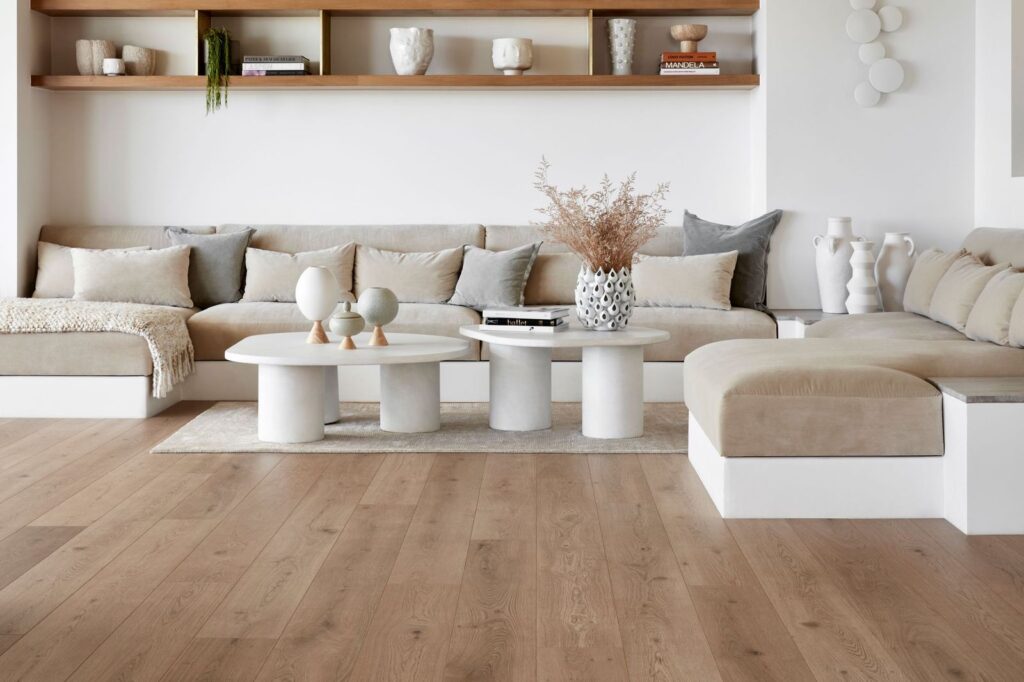If you’re planning to install engineered timber flooring, you’ve probably come across mentions of “expansion gaps” and wondered if they’re really necessary. The short answer is that they are absolutely needed. Skip this seemingly tiny detail, and you could be looking at buckled boards, annoying creaks and expensive repairs down the line.
So let’s go into detail why that little 15mm gap around your room’s perimeter is one of the most important aspects of your flooring installation.
Understanding Engineered Timber Flooring
Engineered timber flooring has earned its reputation as the smart choice for Australian homes. Unlike solid hardwood that’s cut from a single piece of timber, engineered boards are built like a sandwich with a beautiful real wood veneer on top, supported by layers of high quality plywood or composite materials underneath.
This clever construction makes engineered flooring much more stable than solid wood. It laughs in the face of Australia’s temperamental weather, handling our sweltering summers and surprise winter chills without the dramatic warping and shrinking that can plague solid timber. But here’s the thing “more stable” doesn’t mean “completely immune to movement”. Your engineered floors will still respond to changes in humidity and temperature, just more subtly.
The 15mm Secret That Saves Your Floors
An expansion gap is exactly what it sounds like which is a deliberate space left around the edges of your flooring during installation. We’re talking about 10 to 15 millimetres, roughly the width of your pinky finger.
Why leave a gap when you want your floors to look seamless? Because timber is a natural material that never stops reacting to its environment. When humidity rises, your boards expand slightly. When the air dries out, they contract. Without that breathing room around the perimeter, your beautiful new floors have nowhere to go but up, and that’s when you get buckling, gaps between boards or those annoying squeaks that drive you mad at 3am.
The beauty of expansion gaps is that they’re completely invisible once installation is finished. Your skirting boards and trims cover them perfectly, so you get all the benefits without any visual compromise.
What Happens When You Skip the Gap?
We’ve seen it countless times… DIY enthusiasts or inexperienced installers who think they can skip this step because engineered flooring is “more stable”. The results are predictably frustrating.
Buckling is the most dramatic outcome as your boards literally push against each other with such force that they lift away from the subfloor creating an uneven, damaged surface that’s impossible to ignore.
Creaking and popping sounds develop as boards rub against walls or each other under pressure. These noises don’t just disappear, and instead they get worse over time as the friction creates more damage.
Separation and gapping between boards becomes visible as the constant pressure and movement takes its toll on the locking mechanisms and edges.
The frustrating part is that fixing these issues often means pulling up large sections of flooring (and sometimes the entire floor) which turns a simple prevention measure into a major renovation project.

Why Australian Conditions Make This Even More Important
Australia’s climate can be particularly challenging for flooring and our homes experience significanttemperature and humidity swings, especially if you’re anywhere along the coast or in the tropical north. Air conditioning in summer, heating in winter, monsoon seasons and drought periods, your floors experience it all.
During the humid summers, your engineered timber absorbs moisture from the air and expands. Come winter with heating systems running and lower humidity, those same boards contract. Without expansion gaps, this natural cycle creates ongoing stress that compounds over time.
Getting It Right From the Start
While DIY is an option, having them professionally installed will ensure they are fitted correctly. Professional installation isn’t only about having the right tools, it’s also about understanding how timber behaves in your specific environment, and quality installers will:
- Acclimatise your flooring for at least 48 hours in the room where it’s being installed
- Use proper spacers to maintain consistent gaps around the entire perimeter
- Test subfloor moisture levels to ensure optimal conditions
- Account for room size and layout when determining exact gap requirements
Your Floors, Your Investment
Engineered timber flooring represents a significant investment in your home’s comfort, value and aesthetic appeal. So when you’re choosing between different products and installation options, remember that the quality of installation is just as important as the quality of the flooring itself.
Those 15 millimetres around your room’s edge aren’t wasted space, instead they’re an insurance policy for years of beautiful, stable flooring. Whether you’re renovating your entire home or updating a single room, getting this detail right ensures your engineered timber flooring will perform exactly as it should. If you’re looking for quality flooring with expert installation guidance, then contact us to discuss your project and ensure your new floors are built to last.


